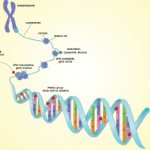They created a multidimensional genomic map of JIA using genome-wide methylation sequencing, RNA sequencing and chromatin immunoprecipitation-sequencing (ChiPseq) for histone marks (H3K4me1 and H3K27ac) in neutrophils. They assessed four patients with untreated, active disease; five with active, treated disease; and five healthy controls.
They also performed whole-genome sequencing on 48 patients with polyarticular, rheumatoid factor-negative JIA.
What they found in the patients with active, untreated disease was striking, said James Jarvis, MD, clinical professor of pediatrics at the University of Buffalo.
“When you look at the histone marks, you see quite different epigenomes in patients with juvenile arthritis,” he said. There were several areas with histone marks with higher peaks and others with loss of histone marks that would be expected.
“These marks were so significant that you could actually crisply sort out active disease from healthy controls both for K4 mono-methylation and K27 acetylation,” Dr. Jarvis said.
These “differentially enriched regions,” he said, were found mostly in intergenetic and intronic areas, not in areas with known genetic variants.
“We could account for only about 20% of the novel histone marks from these regions where we saw obvious genetic variants,” he said.
Treatment brought about changes, Dr. Jarvis said.
“When we treated patients with methotrexate, [we] quickly saw that regions that had shown gains—new histone marks in untreated disease—started to revert toward a pattern you would see in healthy patients,” he said, cautioning that it wasn’t a “correction,” but a move toward normalcy. “The changes in the histones correlated quite well with changes in transcription as we measured it by RNA sequencing.”
Researchers saw changes in methylation as well, once treatment was started, but did not notice clear links with gene transcription, he said.
“Clearly, there are changes in the methylation signature that [are] associated with treatment, but when you test regulatory potential of these altered regions, [we] didn’t see any particular association with gene transcription,” Dr. Jarvis said. “There’s a lot more to be learned about methylation in neutrophils. I think that in a small study like this there’s probably a subtle signature that you can’t see. But we can certainly say that treatment does alter methylation patterns in neutrophils.”
The findings show the apparent power of the environment in JIA, he said.
“Underlying genetic variance does not appear to be a strong driver of these novel epigenomes, consistent with a lot of new data coming out that the environment is a much stronger influence on transcription than underlying genetic variants,” Dr. Jarvis said. “These observations demonstrate the importance of understanding, I think, the function of the noncoding genome both for elucidating disease pathogenesis, [and] for understanding mechanisms of treatment response.”

